#Convert CSV to JSON Easily
Explore tagged Tumblr posts
Text
Unlock Your Potential: The Ultimate Guide to HugeTools.net
In today’s fast-paced digital world, having access to the right tools can make all the difference in boosting productivity, saving time, and achieving success. Enter HugeTools.net , your ultimate toolkit designed to simplify even the most complex tasks. Whether you're a developer, marketer, student, or entrepreneur, this platform has everything you need to get things done efficiently.
Welcome to our comprehensive guide where we’ll explore what makes HugeTools.net so special, highlight its key features, and show you how it can transform the way you work. Let's dive in!
What Is HugeTools.net?
HugeTools.net is an innovative online platform offering a vast array of free tools tailored to meet the needs of modern professionals and hobbyists alike. From text manipulation and image optimization to data conversion and SEO utilities, HugeTools.net provides solutions for almost every task imaginable.
Our mission is simple: empower users by delivering powerful, user-friendly tools that save time, reduce effort, and deliver high-quality results. No matter your skill level, you'll find something here to help you achieve your goals.
Key Features of HugeTools.net
Let’s take a closer look at some of the standout features available on HugeTools.net:
1. Text Tools
Manipulating text has never been easier with our collection of text tools:
Convert case (uppercase, lowercase, sentence case).
Remove extra spaces or duplicate lines.
Generate Lorem Ipsum for testing purposes.
Perfect for writers, developers, and anyone working with large amounts of text.
2. Image Optimization Tools
Optimize your images effortlessly with these handy utilities:
Resize images for web or print.
Convert file formats (JPEG to PNG, etc.).
Add watermarks for branding purposes.
Ideal for designers, bloggers, and photographers who need optimized visuals without compromising quality.
3. Data Conversion Tools
Transform data into different formats quickly and easily:
CSV to JSON converter.
XML to HTML transformer.
Base64 encoder/decoder.
Great for developers and analysts handling complex datasets.
4. SEO & Marketing Tools
Enhance your online presence with our suite of SEO and marketing tools:
Meta tag generator.
URL shortener.
Keyword density checker.
Helps marketers and content creators improve website performance and visibility.
5. Developer Utilities
Streamline coding tasks with specialized developer tools:
Color picker and palette generator.
Regex tester.
QR code generator.
Saves time for developers and simplifies common coding challenges.
Why Choose HugeTools.net?
Here are just a few reasons why HugeTools.net stands out from the competition:
User-Friendly Interface: Our tools are intuitive and require no technical expertise to operate.
Free to Use: Access all our tools without any hidden fees or subscriptions.
Constant Updates: We regularly update our platform with new features based on user feedback.
Reliable Performance: Trust us to deliver accurate results every time.
At HugeTools.net, usability, reliability, and accessibility are our top priorities. That’s why thousands of users worldwide rely on us to simplify their workflows.
How to Get Started
Ready to try HugeTools.net? Follow these simple steps:
Visit https://hugetools.net and browse through the categories.
Select the tool that matches your needs.
Follow the on-screen prompts to input your data or upload files.
Download or copy the output as needed.
Explore additional options within each tool for advanced functionality.
It’s that easy! Within minutes, you’ll be up and running with one of our powerful tools.
Tips and Tricks
To get the most out of HugeTools.net, consider these pro tips:
Combine multiple tools for enhanced productivity (e.g., optimize an image and then add a watermark).
Bookmark frequently used tools for quick access.
Check the "Help" section for tutorials and FAQs if you encounter any issues.
Share your experience with others—your feedback helps us improve!
Success Stories
Don’t just take our word for it—here’s what real users have to say about HugeTools.net:
"As a freelance graphic designer, I rely heavily on HugeTools.net to compress my images before sending them to clients. It saves me hours of work every week!" – Sarah M., Graphic Designer
"The CSV-to-JSON converter saved my team during a tight deadline. We couldn’t have completed the project without it." – John D., Software Engineer
These testimonials speak volumes about the impact HugeTools.net can have on your workflow.
Conclusion
HugeTools.net isn’t just another collection of tools—it’s a powerhouse designed to revolutionize the way you work. With its diverse range of functionalities, commitment to user satisfaction, and constant innovation, there’s no reason not to give it a try.
Start exploring today and discover how HugeTools.net can transform your productivity. Who knows? You might just find your new favorite tool!
Call to Action
Ready to boost your productivity? Head over to HugeTools.net now and start using our free tools! Don’t forget to leave a comment below sharing your favorite tool or suggesting new ones we could add. Happy tooling!
#Secondary Tags (Specific Features)#Text Tools#Image Optimization#Data Conversion#SEO Tools#Marketing Tools#Developer Utilities#CSV to JSON Converter#QR Code Generator#Regex Tester#Meta Tag Generator#Tertiary Tags (Audience & Use Cases)#For Developers#For Marketers#For Students#For Entrepreneurs#For Designers#Work-from-Home Tools#Remote Work Tools#Digital Marketing Tools#Content Creation Tools#Graphic Design Tools#Long-Tail Tags (Specific Phrases)#Best Free Online Tools#Tools for Boosting Productivity#How to Optimize Images Online#Convert CSV to JSON Easily#Free SEO Tools for Beginners#Quick Text Manipulation Tools#Enhance Your Workflow with HugeTools.net
0 notes
Text
i will not apply to the graduate assistant position i will not apply to the graduate assistant position i will not
#sophies ramblings#it pays but im tryna graduate and i should let the francophonists get a chance at it#also half of this this could 100% be automated through a simple python script that converts w JSON and divides texts by word#you can then really easily convert that to CSV and there's your spreadsheet
2 notes
·
View notes
Text
The Ultimate All-in-One File Conversion Tool – Fast, Easy & Free!

The Ultimate All-in-One File Conversion Tool – Fast, Easy & Free!
Are you tired of searching for different tools to convert your files? Say goodbye to the hassle! Our powerful online tool lets you convert PDFs, images, CSV, Excel, HTML, JPG, JSON, PNG, Word, XML, ZIP, WebP, text files, and more—all in one place! Plus, enjoy image resizing and compression with just a few clicks.
Why Choose Our Tool?
1. Save Time & Effort
No more wasting time on multiple websites. Convert any file type instantly without downloading extra software.
2. 100% Free & Secure
Our tool is completely free to use with no hidden charges. Your files are processed securely, and we never store your data.
3. High-Quality Conversions
Get crisp, clear, and accurate conversions every time—whether you’re turning a PDF into Word, resizing an image, or compressing files.
4. Works on Any Device
Access our tool from anywhere—on your phone, tablet, or computer. No installation needed!
5. User-Friendly & Fast
With a simple, clean interface, anyone can use it—no tech skills required! Just upload, convert, and download in seconds.
Who Can Benefit?
✅ Students – Convert lecture notes, research papers, and assignments easily.
✅ Professionals – Quickly edit PDFs, Excel sheets, and Word documents.
✅ Designers & Developers – Resize, compress, and convert images without losing quality.
✅ Business Owners – Handle invoices, reports, and data files efficiently.
How It Works?
1️⃣ Upload your file (PDF, image, Excel, etc.).
2️⃣ Select your desired format.
3️⃣ Convert & Download in seconds!
Stop Wasting Time—Try It Now!
Why juggle between multiple tools when you can do it all in one place? Fast, free, and secure—our converter is the ultimate solution for all your file needs.
🚀 Click Here to Convert Your Files Now! 🚀
[Visit Our Website. www.deeptools.in & Start Converting!]
Don’t wait—boost your productivity today with the easiest file conversion tool online!
This ad highlights the benefits, ease of use, and strong call-to-action to drive traffic to your website. Let me know if you'd like any modifications!
#pdf converter#pdf download#jpg#pdf tool#pdf to word#pdf to excel#pdf master#image converter#image resizer#many others#business#travel#movies#web series
0 notes
Text
Industrial AI solution Data CAMP Easy to use No-code Recipe UI | AHHA Labs

AHHA Labs' DataCAMP is an industrial AI solution designed to enhance manufacturing efficiency through advanced data analysis, real-time monitoring, and AI-driven predictive maintenance. It provides a comprehensive data management and AI automation system that enables industrial sites to optimize processes, reduce downtime, and improve product quality.
Data CAMP Easy to use No-code Recipe UI
Easily implement data pipelines optimized for manufacturing processes with a recipe-based, no-code, block-coding UI.
Easily organize your data pipelines with a no-code block-coding UI
Data CAMP supports a recipe-based, no-code block-coding UI. Users can combine individual recipe items with a drag-and-drop interface to visually configure and modify the entire pipeline, including data pre-processing and transformation.
For example, users can batch collect data such as sensor readings, inspection results, images, and acoustic data from various facilities and inspection equipment by specifying communication protocols like FTP and MELSEC. The collected data can be automatically converted to required formats, such as CSV or JSON, and set to automatically perform basic operations for analysis, including referencing, inserting, removing, merging data, pre-processing for statistics, and triggering events. The output file format for transmission and storage can be specified, and the communication protocol used by the parent system, such as DB or MES, can be specified to automatically transmit and store the processed data.
In short, users can efficiently collect, pre-process, transmit, store, and analyze massive amounts of manufacturing data without the need for complex coding.
High reliability with no-code solution
With a simple UI/UX based on no-code recipes, the application is also more reliable. Human coding can introduce errors, and poorly developed software can sometimes have cascading effects on manufacturing equipment. In the worst-case scenario, the entire system can go down.
This is unlikely to happen with Data CAMP, which uses pre-made recipe files to change settings, minimizing human error. Additionally, because it is organized as micro services, even if a recipe file is written incorrectly, it will only cause a specific pipeline to stop working and not have a cascading effect on other systems.
If you are looking for an industrial AI platform, you can find it at AHHA Labs.
Click here if you are interested in AHHA Labs products.
View more: Industrial AI solution Data CAMP Easy to use No-code Recipe UI
0 notes
Text
Top 6 Scraping Tools That You Cannot Miss in 2024
In today's digital world, data is like money—it's essential for making smart decisions and staying ahead. To tap into this valuable resource, many businesses and individuals are using web crawler tools. These tools help collect important data from websites quickly and efficiently.
What is Web Scraping?
Web scraping is the process of gathering data from websites. It uses software or coding to pull information from web pages, which can then be saved and analyzed for various purposes. While you can scrape data manually, most people use automated tools to save time and avoid errors. It’s important to follow ethical and legal guidelines when scraping to respect website rules.
Why Use Scraping Tools?
Save Time: Manually extracting data takes forever. Web crawlers automate this, allowing you to gather large amounts of data quickly.
Increase Accuracy: Automation reduces human errors, ensuring your data is precise and consistent.
Gain Competitive Insights: Stay updated on market trends and competitors with quick data collection.
Access Real-Time Data: Some tools can provide updated information regularly, which is crucial in fast-paced industries.
Cut Costs: Automating data tasks can lower labor costs, making it a smart investment for any business.
Make Better Decisions: With accurate data, businesses can make informed decisions that drive success.
Top 6 Web Scraping Tools for 2024
APISCRAPY
APISCRAPY is a user-friendly tool that combines advanced features with simplicity. It allows users to turn web data into ready-to-use APIs without needing coding skills.
Key Features:
Converts web data into structured formats.
No coding or complicated setup required.
Automates data extraction for consistency and accuracy.
Delivers data in formats like CSV, JSON, and Excel.
Integrates easily with databases for efficient data management.
ParseHub
ParseHub is great for both beginners and experienced users. It offers a visual interface that makes it easy to set up data extraction rules without any coding.
Key Features:
Automates data extraction from complex websites.
User-friendly visual setup.
Outputs data in formats like CSV and JSON.
Features automatic IP rotation for efficient data collection.
Allows scheduled data extraction for regular updates.
Octoparse
Octoparse is another user-friendly tool designed for those with little coding experience. Its point-and-click interface simplifies data extraction.
Key Features:
Easy point-and-click interface.
Exports data in multiple formats, including CSV and Excel.
Offers cloud-based data extraction for 24/7 access.
Automatic IP rotation to avoid blocks.
Seamlessly integrates with other applications via API.
Apify
Apify is a versatile cloud platform that excels in web scraping and automation, offering a range of ready-made tools for different needs.
Key Features:
Provides pre-built scraping tools.
Automates web workflows and processes.
Supports business intelligence and data visualization.
Includes a robust proxy system to prevent access issues.
Offers monitoring features to track data collection performance.
Scraper API
Scraper API simplifies web scraping tasks with its easy-to-use API and features like proxy management and automatic parsing.
Key Features:
Retrieves HTML from various websites effortlessly.
Manages proxies and CAPTCHAs automatically.
Provides structured data in JSON format.
Offers scheduling for recurring tasks.
Easy integration with extensive documentation.
Scrapy
Scrapy is an open-source framework for advanced users looking to build custom web crawlers. It’s fast and efficient, perfect for complex data extraction tasks.
Key Features:
Built-in support for data selection from HTML and XML.
Handles multiple requests simultaneously.
Allows users to set crawling limits for respectful scraping.
Exports data in various formats like JSON and CSV.
Designed for flexibility and high performance.
Conclusion
Web scraping tools are essential in today’s data-driven environment. They save time, improve accuracy, and help businesses make informed decisions. Whether you’re a developer, a data analyst, or a business owner, the right scraping tool can greatly enhance your data collection efforts. As we move into 2024, consider adding these top web scraping tools to your toolkit to streamline your data extraction process.
0 notes
Text
What Is XML Conversion Services and How Can It Simplify Your Work?

Whether the site being managed is a website, an online store, or even just a simple storage of files, how you store and transfer data matters a lot. Among the tools of processing data is XML, Extensible Markup Language. Now, what would happen when data needs to be converted from one format to XML and vice versa? This is where XML conversion services come in.
In this blog, we’ll break down what XML conversion services are and why they are important for businesses and individuals working with data.
What is XML?
Before diving into XML conversion, let's quickly understand what XML is.
XML - Extensible Markup Language: It is a way to store and transport the data in an ordered form readable both by human and machines. Unlike other formats, XML fits the two criteria: readability by humans as well as by the machines. These features make it possible to share and process data easily between different systems and applications.
XML is used in e-commerce, health care, finance and publishing fields, among others, to store information in a manner accessible and editable by several types of software’s and systems.

What Are XML Conversion Services?
XML conversion services are the entire process of converting data from any format-for example, CSV, JSON, HTML, Excel, or PDF-to XML, or vice versa. They are vitally essential because several applications and systems require data in certain formats to work properly.
For example, your product information is in an Excel file that you should transform into XML to upload to an e-commerce web site, or maybe you have an XML file with data from a partner company that you received not being useful in this format, but you need it in some other format, such as CSV, to analyze in an application like the spreadsheet.
XML conversion services help bridge the gap between these different file formats.
Why Do You Need XML Conversion?
Here are a few reasons why XML conversion services are useful:
Data Compatibility: There are different file formats being used by different systems, and not all the software supports reading or working with XML directly. Data becomes compatible with a large range of systems and applications by making it XML compatible.
Simplifies Data Exchange: XML is a pretty acceptable format to transfer data from one platform to the other. Where there are a number of partners or systems in use, then converting the data in, say, XML format can make data transfer much smoother.
Data Organization: XML can also be used to organize larger volumes of data in a much more structured way than what other mediums may offer. In fact, if your data does not already come in XML format, converting it could even improve its organization and make it more accessible.
Improves Data Accuracy: You’re always at risk of error when you have to convert data manually. XML conversion services automate the process and guarantee accuracy when the data is moving from one format to another.
Efficient for Web Development: Since most websites and content management systems use XML to structure the contents, you are likely to also need to convert your data to XML if you're creating or maintaining a site- at the very least for product catalogs, user information, or a site map.
Types of XML Conversion Services
There are various types of XML conversion services available, depending on the specific needs of the business or individual:
XML to CSV Conversion: It converts XML data to the CSV data format, which often relies on Microsoft Excel. That's mostly good for simple, tabular analysis and data manipulation.
CSV to XML Conversion: Converting the data stored in a CSV format into XML is this one. Where you want to structure your data in web applications or those databases which need to use XML, this is very useful.
XML to JSON Conversion: JSON (JavaScript Object Notation) is a lightweight data format that’s easy for humans to read and write. It’s commonly used in web development, especially in APIs. If you have XML data but need it in JSON format, this conversion service can help.
Excel to XML Conversion: Many organizations maintain their data in Excel sheets. In case you have to upload that data to any system accepting XML, then converting the Excel to XML will help it fit into the system.
PDF to XML Conversion: This service may also come in handy in case of such a need arising where the information is maintained in the PDF file format and needs to further transform into an XML file in order to process the data or for further analysis.

How XML Conversion Services Work
The process of XML conversion generally involves a few key steps:
Data Extraction: The first step is to extract the data from the original file format (whether that’s CSV, PDF, Excel etc.)
Data Mapping: Our data is then built from the extracted data and mapped to the correct XML tags and structure. This makes it so the data is stored in a XML format in which it is readable and makes sense.
Validation: Checks the converted XML file to make sure it’s in a correctly formatted and error free format. This step makes sure our XML is valid so it can be processed well by other systems without problems.
Delivery: and finally, the XML file you have converted is provided to you in the format of your choice. It could be a downloadable file or it could be an integration with your software or system.
Benefits of Using XML Conversion Services
Time-Saving: Converting large amounts of data by hand can be a slow affair. XML conversion services make the process of using them automatic and taking less of your time and effort.
Cost-Effective: Businesses can reduce manual labor and avoid the high expense of human error due to manual data entry by automating data conversion.
Accuracy: XML conversion doesn’t always require you to have human eyes conducting it. Automated XML conversion effectively reduces the risk of errors during the process. This keeps the data accurate so that it can be used for use in various applications.
Scalability: However, in this case, businesses that receive and record growing volumes of data need not lose efficiency as they scale up their data processing needs, but can utilize XML conversion services for optimization.
Conclusion
Simply put, XML conversion services revolve around making your data accessible from one platform to another through XML data conversion or converting XML from a source format. Be it in the form of spreadsheets or as a PDF, any data format with the aid of such services can rest assured that your data will be well-organized and compatible with many applications.
XML conversion services can save you time, reduce errors and make your workflow more efficient when you’re dealing with large volumes of data, or if you’re sharing data between systems.
0 notes
Text
Python Fundamentals for New Coders: Everything You Need to Know
Learning Python is an exciting journey, especially for new coders who want to explore the fundamentals of programming. Known for its simplicity and readability, Python is an ideal language for beginners and professionals alike. From understanding basic syntax to mastering more advanced concepts, Python equips you with tools to build everything from small scripts to full-scale applications. In this article, we’ll explore some core Python skills every new coder should know, such as file handling, reading and writing files, and handling data in various formats.
One essential skill in Python is file handling, which is vital for working with external data sources. Our Python file handling tutorial covers how to open, read, write, and close files. In real-world applications, you often need to process data stored in files, whether for analysis or to store program output. File handling enables you to manage these files directly from your Python code. With just a few commands, you can open a file, modify its contents, or create a new file. This skill becomes especially valuable as you begin working with larger projects that rely on reading or writing to files.
Once you understand file handling basics, you can dive deeper into how Python works with different types of files. One common use case for file handling is working with CSV files, which store data in a table-like format. Python CSV file handling allows you to read and write data organized in rows and columns, making it easy to process structured data. With Python’s built-in csv module, you can access and manipulate CSV files effortlessly. For example, if you have a list of students and their grades in a CSV file, you can use Python to calculate average grades or filter data. Understanding how to handle CSV files helps you manage structured data effectively and is a critical skill for any data-related task.
Moving on, another key skill is working with file content—specifically, learning to read and write files in various formats. Python offers a variety of methods for reading files line-by-line or loading the entire content at once. Writing to files is just as simple, allowing you to add new data or update existing information. For instance, in a data analysis project, you might read raw data from a file, process it, and save the results to another file. This read-and-write capability forms the backbone of many Python programs, particularly when dealing with external data.
Finally, many applications require more complex data storage and exchange formats, such as JSON. Python JSON data processing is essential for working with APIs or handling nested data structures. JSON, which stands for JavaScript Object Notation, is a popular format for representing structured data. Using Python’s json module, you can easily convert JSON data into Python dictionaries and vice versa. This ability to parse and write JSON data is crucial for building applications that interact with web services, allowing you to read data from an online source and process it in your program. As you gain more experience, you’ll find JSON data handling indispensable for projects involving external APIs and structured data storage.
Our company is committed to helping students learn programming languages through clear, straightforward tutorials. Our free online e-learning portal provides Python tutorials specifically designed for beginners, with live examples that bring each concept to life. Every tutorial is written in an easy-to-understand style, ensuring that even complex topics are approachable. Whether you’re a student or a hobbyist, our tutorials give you the practical tools to start coding confidently.
In summary, understanding Python fundamentals such as file handling, CSV and JSON processing, and read/write operations can take you far in your coding journey. Each of these skills contributes to building powerful applications, from data analysis scripts to interactive web applications. By mastering these concepts, you’ll be well-prepared to tackle real-world coding challenges, and our platform will support you every step of the way. With consistent practice and our structured tutorials, you’ll gain the confidence to explore Python and bring your ideas to life.
0 notes
Text
PDF to IP creation- Smart Datasheet

Creating a Smart Datasheet from a PDF for Intellectual Property (IP) generation is an innovative approach to document transformation. A smart datasheet provides a dynamic, interactive, and enhanced experience compared to the static nature of a traditional PDF. The process of converting a PDF into a smart datasheet for IP creation revolves around structuring information, integrating metadata, and leveraging advanced tools to unlock the potential value of the data within the document. Here's an in-depth guide on how this transformation unfolds and how it benefits IP creation.
1. Understanding the Smart Datasheet Concept
A smart datasheet goes beyond the static nature of PDFs. While PDFs present information in a fixed layout, a smart datasheet is more dynamic. It organizes data in a way that is easy to manipulate, retrieve, and analyze. This transformation is particularly crucial for industries that thrive on data-driven decision-making, such as technology, pharmaceuticals, and engineering.
For IP creation, a smart datasheet not only makes it easier to access data but also facilitates innovation. By making the data more accessible and structured, it enables quicker cross-referencing of previous inventions, patents, and technical specifications. Thus, creating a smart datasheet from a PDF is the first step toward improving the workflow of IP professionals.
2. Converting PDF to Structured Data
The first step in transforming a PDF into a smart datasheet involves converting its content into a structured format. PDFs, while great for preserving layouts and designs, are not always user-friendly when it comes to data extraction. By converting the PDF into a structured format such as CSV, XML, or JSON, the information becomes more searchable, sortable, and editable.
Modern tools like Optical Character Recognition (OCR) software play a crucial role in this process. They convert non-editable text from scanned PDFs into machine-readable formats. Once this data is digitized, it can be easily indexed, categorized, and organized into the smart datasheet. This step ensures that IP professionals can extract relevant information quickly, improving the speed and efficiency of the IP creation process.
3. Adding Metadata and Enhancing Context
One of the key components of a smart datasheet is the integration of metadata. Metadata helps to add context to the raw data by describing the content in a way that is meaningful to IP experts. For example, in a technical datasheet, metadata might include the author’s name, versioning history, patent classification, and keywords related to the technical field.
In the context of IP creation, metadata can help link the datasheet to existing patents or research work. This adds an additional layer of intelligence to the document, allowing IP professionals to easily trace the origins of an idea, the evolution of technology, or cross-reference previous filings. This step is invaluable for prior art searches or ensuring that the IP being created is original and non-infringing.
4. Leveraging Smart Technologies
Once the data is structured and the metadata is added, the next step is to leverage smart technologies to make the datasheet more interactive and insightful. Artificial intelligence (AI) and machine learning (ML) can be integrated into smart datasheets to provide automated suggestions, predictive analysis, and intelligent summaries.
For example, when an IP professional inputs specific keywords into the smart datasheet, the system can suggest related patents, technological advancements, or similar innovations that may have occurred in the past. It could also generate alerts about potential patentability issues or suggest areas for further research. This makes the smart datasheet a powerful tool in the hands of inventors and patent professionals.
5. Improving Accessibility and Collaboration
A major benefit of a smart datasheet is that it is accessible and shareable across various platforms and devices. Unlike static PDFs that can be cumbersome to navigate on mobile devices, smart datasheets can be designed with responsive layouts. This makes it easier for teams spread across different locations to access the information they need without being tied to their desktops.
Moreover, these smart datasheets can be integrated into cloud-based IP management systems, allowing for real-time collaboration. Team members can comment, annotate, or update the datasheet as the invention or research evolves. This streamlined collaboration reduces the time needed for IP filing and enhances the overall productivity of the team.
6. Enabling Faster IP Creation
The ultimate goal of transforming a PDF into a smart datasheet is to accelerate the IP creation process. By having data structured, indexed, and enhanced with metadata, IP professionals can avoid repetitive tasks like manually searching for information or re-structuring content for different purposes.
Smart datasheets enable faster prior art searches, automated report generation, and easier collaboration, all of which reduce the time it takes to create IP. As a result, inventors and patent attorneys can focus more on innovation and less on administrative overhead.
7. Compliance and Security
For organizations involved in sensitive industries, ensuring that the smart datasheet complies with legal and security standards is vital. Smart datasheets can be embedded with access controls, encryption, and tracking features that monitor who accesses or modifies the document. This ensures that sensitive information, especially IP-related data, is secure and complies with industry regulations.
Furthermore, audit trails within smart datasheets help track the evolution of the document, ensuring transparency and accountability. This is particularly important in patent litigation cases or disputes regarding IP ownership.
Conclusion
Converting a PDF into a smart datasheet represents a significant advancement in how information is managed for IP creation. By structuring data, integrating metadata, and leveraging AI-powered tools, smart datasheets enable faster, more efficient, and secure IP development. In a world where data is king and innovation is the driving force of success, transforming PDFs into smart datasheets is not just a technological upgrade, but a strategic advantage for organizations looking to protect and enhance their intellectual property assets.
0 notes
Text
Make Data Management Simple with JSON to CSV
Need a quick way to handle JSON data? Our tool converts JSON to CSV effortlessly, so you can focus on what matters. Fast, reliable, and super easy to use – your go-to data conversion tool is here!
0 notes
Text
Eloiacs Xml Conversion
Streamline Your Data with Eloiacs XML Conversion Services
In today’s digital era, the efficient management and exchange of data are crucial for businesses to thrive. Eloiacs offers cutting-edge XML conversion services designed to help you seamlessly transform your data into versatile and easily manageable XML formats. Our expertise in XML conversion ensures that your data is not only structured for optimal use but also primed for interoperability across various systems and platforms.
Why choose Eloiacs for XML conversion?
Expertise and precision At Eloiacs, we pride ourselves on our deep technical knowledge and meticulous attention to detail. Our team of experts employs advanced techniques to convert your data into XML with the highest level of accuracy, ensuring that every piece of information is correctly formatted and structured.
Customised Solutions We understand that each business has unique requirements. Our XML conversion services are tailored to meet your specific needs, whether you require conversion from HTML, JSON, CSV, Excel, InDesign, PDF, or any other format. We work closely with you to develop solutions that align with your business objectives and technical specifications.
Enhanced data interoperability XML is a widely accepted format that facilitates seamless data exchange between different systems and applications. By converting your data to XML, Eloiacs helps you enhance interoperability, making it easier to integrate with various software and platforms, thereby improving your business processes.
Improved data management Structuring your data in XML not only makes it more accessible but also significantly improves data management. Our XML conversion services ensure that your data is organised in a hierarchical format, making it easier to search, retrieve, and manipulate. This leads to better data governance and more informed decision-making.
Compliance and Standard Adherence Eloiacs ensures that all XML conversions adhere to industry standards and compliance requirements. Our conversions are designed to meet the specifications of various industries, including finance, healthcare, publishing, and more, ensuring that your data is compliant with relevant regulations and standards.
Our XML Conversion Process
Consultation: We begin with a thorough consultation to understand your data conversion needs and objectives. Assessment: Our team conducts a detailed assessment of your existing data formats and structures. Custom Plan: We develop a customised XML conversion plan, outlining the steps and tools required for the process. Conversion: Using advanced tools and techniques, we convert your data into XML, ensuring accuracy and compliance. Quality Check: We perform rigorous quality checks to ensure that the converted XML data meets all specified requirements. Delivery and Support: Upon successful conversion, we deliver the XML files and provide ongoing support to address any issues or further requirements. Get Started with Eloiacs XML Conversion Services
Transform your data into a powerful asset with Eloiacs XML conversion services. Whether you are looking to improve data interoperability, enhance management, or ensure compliance, our team is here to help. Contact us today to learn more about how our XML conversion services can benefit your business and streamline your data processes.
0 notes
Text
Mastering CAD Conversion: A Step by Step Guide
Are you ready to dive into the world of CAD conversion and unlock its potential for your design projects? Whether you're a seasoned professional or a novice in the field, mastering CAD conversion is essential for efficient design processes and improved project outcomes.
Imagine having the ability to seamlessly convert paper drawings, point clouds, and various data types into accurate CAD files. With CAD conversion, you can transform physical objects and hand-drawn sketches into versatile, digital formats that can be easily edited, analyzed, and shared.
CAD Conversion
CAD conversion, also known as Computer-Aided Design conversion, is the process of transforming design files from one format to another. It plays a crucial role in today's data-driven design process, enabling the efficient use of resources and facilitating collaboration among various teams.
Design projects often involve working with physical objects, hand-drawn sketches, or raster-based CAD software. To bring these diverse sources together and ensure seamless integration, CAD conversion is necessary. It allows designers to convert data from one digital format to another, such as from a hand-drawn sketch to a versatile CAD file.
In addition, CAD conversion enables the implementation of advanced techniques, such as converting point cloud data into accurate 3D models of real-world objects. This precise information extraction expands the boundaries of design possibilities and fosters innovation in industries like engineering and construction.

Understanding Different Types of Data Conversion Services
Data conversion services play a crucial role in today's data-driven world, enabling the efficient use of resources and facilitating the management of data in various systems. There are several types of data conversion services available, each catering to specific needs and objectives. Let's explore some of the most common types and their benefits and applications:
1. Document Conversion:
Document conversion involves transforming documents from one digital format to another. It allows for easy sharing and access to information, regardless of the original format. This service is especially useful for businesses dealing with large databases of CAD data, as it ensures seamless compatibility and enhances data interoperability.
2. Image Conversion:
Image conversion involves converting images from one format to another. It enables the manipulation and utilization of images in different applications and platforms. This service is utilized in industries such as graphic design, advertising, and photography, where file types, resolutions, and optimizations are crucial.
3. Audio and Video Conversion:
Audio and video conversion involves converting audio and video files to different formats. It ensures compatibility across various media players and devices, allowing for easy distribution and viewing. This service is commonly used in the entertainment industry, multimedia production, and online streaming platforms.
4. Ebook Conversion:
Ebook conversion involves transforming books and documents into electronic formats, such as EPUB or MOBI. This service enables easy distribution and reading on e-readers, tablets, and mobile devices. It is widely used in the publishing industry and supports the growing demand for digital reading.
5. Data Format Conversion:
Data format conversion involves converting data from one format to another, such as CSV to XML or JSON to Excel. This service ensures data compatibility and facilitates data analysis and integration across different systems. It is essential for businesses dealing with diverse data sources and applications.
6. CAD Conversion:
CAD conversion involves converting CAD (Computer-Aided Design) files to various formats, such as DWG or DXF. It allows for sharing and collaboration among different CAD tools and platforms, making it crucial for architectural design, engineering projects, and construction industries.
The AutoCAD Conversion Process
Converting paper drawings to AutoCAD involves several essential steps that ensure accurate digitization and seamless integration into the CAD software. Follow this step-by-step guide to successfully transform your hand-drawn sketches into precise and versatile CAD files.
Step 1: Data Acquisition
Start by gathering all the necessary paper drawings. Ensure that the drawings are clean and legible, as this will streamline the conversion process. Organize the drawings in a logical order, facilitating the reconstruction of the entire design.
Step 2: Digitization
To convert the paper drawings into a digital format, use a high-quality scanner or a camera to capture clear and detailed images. Maintain consistency in file formats and resolutions to enhance accuracy during the conversion process.
Step 3: CAD Software Usage
Import the digitized drawings into an AutoCAD-compatible software. The CAD software provides advanced tools and functionalities for precise design modifications, layer management, and dimensioning. Utilize the software's features to enhance the digitized drawings and optimize the design.
Step 4: Quality Control
Thoroughly review the converted drawings to ensure accuracy and integrity. Pay attention to details, such as line weights, dimensions, and annotations. Validate the dimensions against the original drawings and make any necessary adjustments. Conduct rigorous quality checks to eliminate errors and discrepancies.
Throughout the conversion process, it is crucial to maintain the highest level of attention to detail and accuracy. By following these steps, you can effectively convert your paper drawings to AutoCAD and leverage the versatility of CAD software for your design projects.
0 notes
Text

The thing about Linux and Unix CLI is you don't need those 3rd party websites or apps for most tasks. From DNS queries to file conversion, everything is possible at the CLI without the cloud. Save money. Save time. Have good privacy. Enjoy the best of both worlds!
-> How to convert JSON to CSV using Linux / Unix shell
-> macOS users can easily have these tools with Homebrew: How to install Homebrew on Mac OS to use the brew package manager and Windows developers or uses now have WSL as a reliable way to use all those classic *nix tools.
18 notes
·
View notes
Link
7 notes
·
View notes
Text
15+ Figma Plugins to Help You Design Better
Figma, the second most-used tool for designing user interfaces (and the first most-used tool when counting only Windows OS), has really taken the digital design industry by storm lately, with even Adobe XD shipping their own version of Figma’s multiplayer feature (naming it “coediting”).
However, the hot topic at Figma right now is the release of plugins — extensions that Figma users can install on Figma to allow for extra functionality or to improve their design workflow.
Let’s take a look at some of the best Figma plugins so far.
1. Arrow Auto (create user flows)

Arrow Auto adds flowchart functionality to Figma, which is useful for creating user flow maps. Select any two objects on the canvas and Arrow Auto will enable you to draw a connector between them. You can also hide and show the flows on demand.
Autoflow is a decent (and maybe nicer looking) alternative, but Arrow Auto has more features, including the ability to switch connector directions and also move connected objects around while keeping connectors intact.
2. Angle (utilize device mockups)

Angle allows you to display your screens (i.e. artboards) from within a number of realistic or matte-effect device frames that each come with a variety of angle options and shadow styles.
Impressively, they’re 100% vector as well.
Artboard Studio isn’t quite the same thing, as it allows for inserting a whole bunch of random 3D objects onto the canvas (like a kiwi, for example). If you only care about device mockups, I’d install Angle. Vectory 3D is similar to Artboard Studio, but it outputs actual 3D assets.
3. Master (manage components more easily)
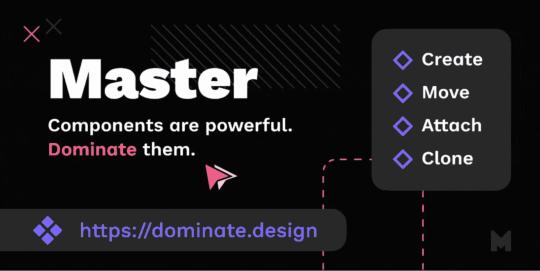
Master offers a better way to manage components, such as the ability to turn multiple identical objects into a component, duplicate components into other Figma files, and much more.
4. Clean Document (auto-clean documents)
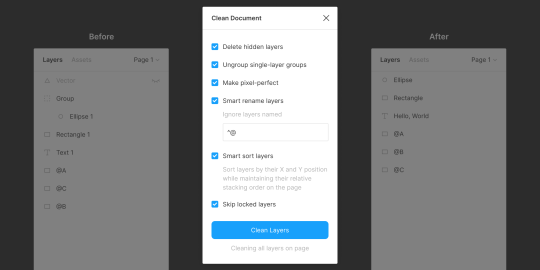
Clean Document, well … cleans your document! It deletes hidden layers, sorts them intelligently, renames them according to your liking, ungroups single-layer groups, and even rounds dimensions to the nearest pixel. A terrific tool for obsessive neat freaks!
5. Similayer (select similar layers)
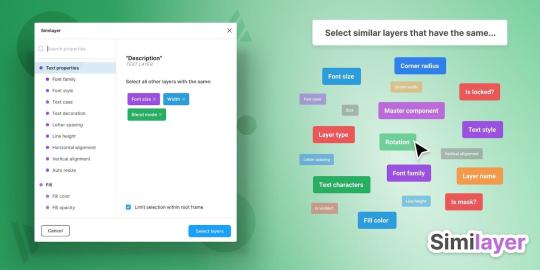
Quite simply, Similayer allows you to select layers based on their similarity to the layer that’s currently selected. Let’s say that you wanted to change a shadow style that’s being used on a number of different elements: Similayer could do that.
You could also use it to batch-reassign multiple components.
6. Viewports (change the viewport)
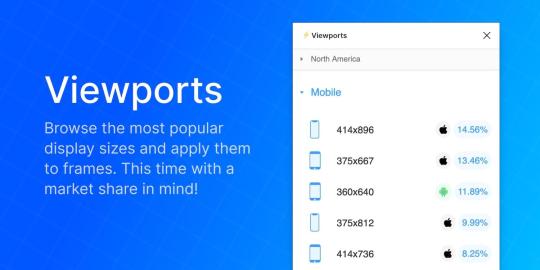
Find out the correct market share of all viewport dimensions, then apply them to frames. It’s insane how useful this is!
Viewport data is live-sourced from StatCounter.
7. Todo (create todo lists)

There are dozens of terrific todo lists, but this one exists within Figma. It’s not designed to replace your everyday todo list, but it’s a more convenient way of keeping track of your design-specific todos without needing to leave Figma. Have a list of changes to make? Need to establish priorities?
If so, install Todo.
8. Font Scale (establish a font scale)
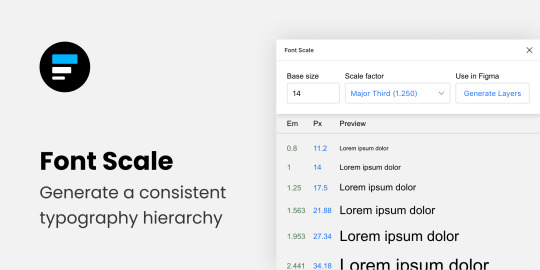
Establish a visually consistent/hierarchical font scale by choosing a base size and scale factor, then save the results to your document for continuous reference (as either em or px).
9. Content Reel (insert better-than-lorem-ipsum content)

Content Reel inserts “real” content into your design. Need a quick address? Or an avatar? For some reason can’t think of a single name when you need one? Content Reel has your back.
Designing with real data ensures that the design doesn’t look odd once developed, and also helps us to design for edge cases.
10. Google Sheets Sync (sync data from Google Sheets)
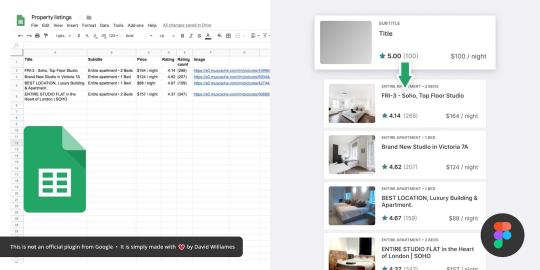
Whether your app has an API or you just want to create a table of data manually, Google Sheets Sync will basically allow you to sync this data directly into Figma. It’s like Content Reel, but instead you define the data yourself. It’s useful for designers that want to build ultra-realistic mockups with data from their actual niche (or live application), and it’s especially useful for teams that want to design using the same library of data.
11. Chart (create “real data” charts)
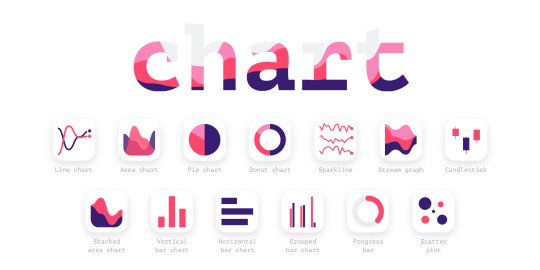
Create stunning, customizable charts with data from Excel, Numbers, Google Sheets, or simply import a local CSV or JSON file. Datavizer is suitable alternative, but Chart can also sync with live JSON (i.e. you can connect Chart to a REST API).
12. Iconify (utilize icon fonts)
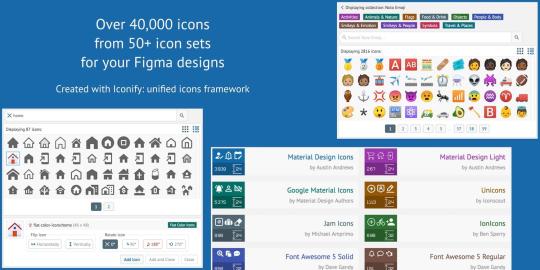
All icon fonts, right inside Figma. Material Design Icons, FontAwesome, Jam Icons, EmojiOne, Twitter Emoji — you name it.
Pretty iconic, really.
13. Figmotion (create animations)
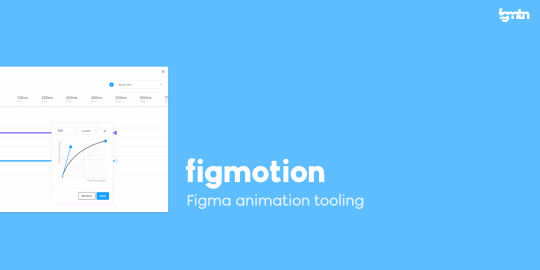
If the thought of exploring animation scares you, or you dread switching tools to access advanced animation features, Figmotion makes animation a lot less anxiety-inducing. The animations are also easy to hand off, since they’re based on web technologies.
14. Split Shape (make columns … and stuff)
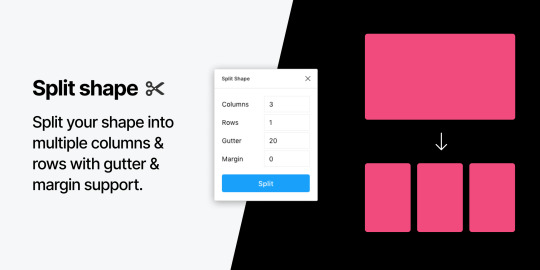
An interesting method of creating columns, Split Shape splits, say, a rectangle into multiple rectangles from which you can then create columns (or rows, or whatever). Split Shape can be used for various things if one thinks outside the box! 😁
15. Remove BG (create transparent bitmaps)

Remove BG is a web tool that removes the background of bitmap images, effectively turning them into transparent PNGs. Remove BG for Figma essentially does the same thing, but within Figma.
If you’ve been hoarding Adobe Photoshop only so that you can remove backgrounds, you can now delete it and probably free up approximately 80 thousand million GBs of space on your SSD 😌.
Popular Figma Plugins
There are a few Figma Plugins that I didn’t mention because they’re already super well-known to users of other UI design tools such as Sketch. You probably have these ones already:
Confetti (create dispersions)
Unsplash (insert stock images)
Rename It (rename layers more efficiently)
Humaaans (insert mix-n-match illustrations)
Stark or A11y – Color Contrast Checker (measure color contrast)
Bonus Figma Plugins
These Figma Plugins are awesome, but you might not need them often (if at all). It’s nice to know they’re there, though.
Arc (arch text)
Roto (rotate-extrude shapes)
Table Generator (create tables)
To Path (create text on a path)
Brandfetch (source brand assets)
Isometric (make objects isometric)
Mapsicle or Map Maker (create maps)
Skew (create simple isometric mockups)
Image Tracer (convert bitmaps to vectors)
Shadow Picker (intelligently create shadows)
Metaball/Blobs/Waves (create abstract shapes)
And finally, all Figma Plugins (in case you just can’t get enough of ’em! 😉).
Keen to learn the ins and outs of developing your own plugins, either to improve your workflow or the workflow of others? Check out Figma’s Plugin Docs.
13 notes
·
View notes
Text
Snowflake Data Lake – Overview and Best Practices
A cloud-based data warehousing solution, the Snowflake Data Lake provides unlimited storage and computing facilities. Users can seamlessly scale up or down in data usage, paying only for the resources used, unlike traditional systems where flat fees are charged. It is cost-effective for businesses facing a sudden spike in demand for data storage as they do not have to invest heavily in additional hardware or software to meet this excess demand.
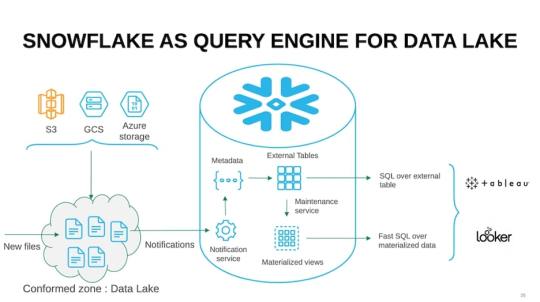
The Snowflake Data Lake is a high-performing platform that allows multiple users to simultaneously execute intricate queries without facing any slowdown in speeds and performance.This is a very critical requirement in the modern data-driven business environment. Further, the extendable structure of the Snowflake Data Lake makes sure that databases are seamlessly loaded within the same cloud ecosystem so that businesses do not have to choose a specific data warehouse or a data lake to operate on.
An example will explain this aspect better. For instance, data generated through Kafka can be transferred to a cloud bucket from where the data is converted to a columnar format with Apache Spark. This can then be loaded to the conformed data zone, doing away with the need for organizations to choose between a data lake or a data warehouse.
The Snowflake Data Lake can also load data in its native format – unstructured, semi-structured, or structured – thereby allowing cutting-edge business analytics in mixed data formats. This increases the efficiency of the Data Lake many times over and since it is highly scalable, it reacts immediately to any decrease or increase in data volumes.
Features of the Snowflake Data Lake
Because of its several optimized features, the Snowflake Data Lake is a powerful data-driven solution for organizations. Here are some of them.
Scalability: Snowflake has very dynamic and scalable computing resources that vary according to the volume of data requirements and the number of users at a particular point in time. The quantum of resources provided changes automatically without affecting running queries whenever there is a rise or fall in computing needs. To cope with a sudden spike in demand, the compute engine auto-adjusts to the increased flows without a drop in speed or performance. Single-point data storage: The Snowflake Data Lake can directly ingest large volumes of structured and semi-structured data such as JSON, CSV, tables, Parquet, ORC, and more without the use of separate silos for data storage. Cost-effective data storage: Snowflake provides flexible and very cost-effective data storage solutions as users have to pay only for the base cost charged by its cloud providers such as Microsoft Azure, Amazon S3, and Google Cloud. Guaranteed data consistency: This is possible as the Snowflake Data Lake can easily manipulate cross-database links and multi-statement transactions.
Summing up, Snowflake Data Lake users, therefore, have the benefits of affordable computing and storage facilities along with maximized scaling capabilities.
0 notes
Text
Free Excel to JSON Converter

There are many articles that explain how to convert data from an Excel spreadsheet into a JSON format. This is because the data in a JSON format can be easily read by a web application. It can also be easily converted back into Excel format if needed.
What's JSON File Form?
JSON (JavaScript Object Notation) is a lightweight data-interchange format. - It is easy for humans to read and write. - It is easy for machines to parse and generate. - It is based on a subset of the JavaScript Programming Language, Standard ECMA-262 3rd Edition - December 1999. JSON is a text format that is completely language independent but uses conventions that are familiar to programmers of the C-family of languages (C, C++, JavaScript, etc.). These properties make JSON an ideal data-interchange language.
Can Excel generate JSON file?
You would need to use a third-party tool or write a custom script to generate a JSON file from Excel data.
How do I convert an Excel file to JSON?
The process of converting Excel to JSON is fairly simple. You can convert or export excel to json ( xls to json , xlsx to json...) - Manually, - the data in the Excel spreadsheet is exported to a CSV file. - Next, the CSV file is converted to a JSON file using a online converter tool. - Finally, the JSON file is imported into the web application. - Using a Free Converter Excel to Json Online: - Excel To json Converter The JSON format is very popular for web applications because it is easy to read and understand. It is also easy to convert back to Excel if needed. Read the full article
0 notes